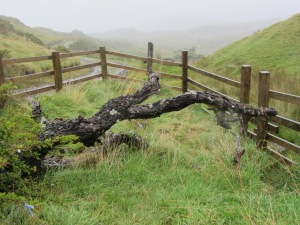The following post was written by Dr. Ceri Houlbrook, an expert on wishing-trees who has taken a particular interest in the Ardmaddy Wishing-Tree in Argyll.
Money doesn’t grow on trees, claims the old proverb – but it does if people hammer coins into them. And this is exactly what’s been happening on the Ardmaddy Estate in Argyll for about 100 years now.
Lying beside a muddy, little-traversed track leading from Ardmaddy Bay to Degnish Peninsula, in a narrow pass aptly named Bealach na Gaoithe (‘pass of the winds’), is the Ardmaddy Wishing-Tree. It’s a melancholy-looking specimen; a hawthorn (Crataegus monogyna), years dead, gnarled and wind-blasted. But while the tree’s sorry state may capture your sympathy, it’s something else that will capture your attention: the coins embedded into its knotted bark. Hundreds of them, seemingly enveloping the tree in a rainbow of metallic hues, from copper and silver to the patinated blues and greens of verdigris – a testimony to how long these coins have been there.
But, being both an archaeologist and naturally pedantic, I wanted to know exactly how long they’d been there. And so, in 2013, I led a team of archaeologists from the University of Manchester to undertake a small-scale, non-invasive excavation at the site, funded by the Heritage Lottery Fund (details on my blog). Digging around the tree, taking the utmost care to not touch the tree itself, we recovered 691 coins that had fallen from the bark and become buried over time. These coins dated from 1914 to 2011, thus representing almost a century of coin deposition. Bearing in mind the small scale of the dig, I imagine there are many more coins buried still deeper – and how many might have been swallowed up by the tree itself? Clearly people have been embedding their coins into this wizened hawthorn for many years – and apparently still are today.
But why, you might ask. Local custom avers that you deposit a coin into this venerable tree in exchange for a wish (hence the name), in a practice not dissimilar to the wishing-well or -fountain. Indeed, coins have been universally surrendered in wish-fulfilment rituals throughout history; as poet Kathleen Jamie observed, pennies are the ‘common currency of longing’. But tossing a coin into a fountain, a well, a spring, is quite different to embedding one into the bark of a tree. Is there something significant about trees?
People have been tying rags and ribbons to branches for generations, in a custom said to heal: illnesses and sorrows are believed to pass from the sufferer, through the rag or ribbon, into the tree, which bears them all in stoic silence. Perhaps the Ardmaddy Wishing-Tree is employed to the same ends. Certainly the hawthorn has a long history of being considered both sacred and therapeutic, and in Scottish folklore it’s considered to mark the entrance to the Otherworld. It’s unsurprising then that people would surrender their coins – the ‘common currency of longing’ – to a tree associated with fairies and spirits: after all, who better to grant wishes?
This custom isn’t limited to the Ardmaddy Estate – indeed, it’s not limited to Scotland. These trees are found all over the British Isles. Some are old, most are new, showing that people in their thousands are still surrendering coins in exchange for wishes – and proving that money really does grow on trees.


